Pinos Altos
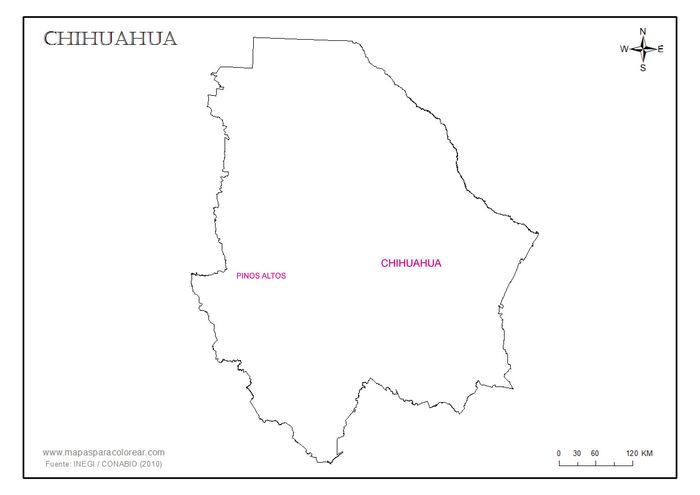
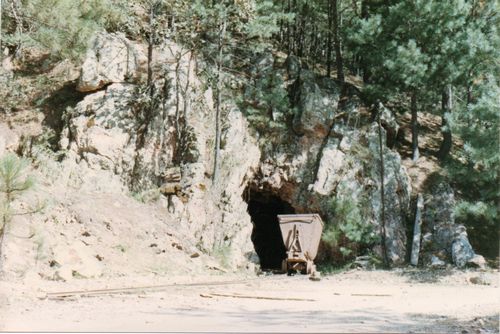
Pinos Altos (in 1991, now destroyed)
Pinos Altos is on a mountain top about fifteen miles north of Jesús María (now Ocampo). Now it is easily reached from the Chihuahua-Sonora highway west of Basaseachic but as the new owners have stripped away the hillside there is no longer much to see.
In 1877 the mines were sold by their Mexican owners to the Anglo-American Negociación de Pinos Altos (or Compañía Minera de Pinos Altos) headed by John Buchan Hepburn. Hepburn paid $100,000 for the property and spent even more on establishing a hacienda de beneficio and opening up the mines.
Hepburn kept an account with the Banco Mexicano and every month brought in as much paper money and hard cash as he thought necessary. However, occasionally the notes ‘ran out’ before the stage arrived and at other times it was necessary to delay the stage. At these times Hepburn, who had the only store in Pinos Altos, did not have enough notes to pay his accounts, so he decided to issue his own paper. These were redeemed periodically, at par, with Banco Mexicano notes when the stage arrived from Chihuahua. The amount in circulation fluctuated between $40,000 and $50,000.

main street and tienda de raya, Pinos Altos
At some time (in 1882 or 1883 according to Enrique Creel’s reminiscence in 1920 but probably earlierOtherwise, the timetable is too tight. However, Pinos Altos seemed particularly susceptible to fire as the entire business section was destroyed by a fire, started when a lamp overturned in a casa comercial, on 29 May 1884 (La Libertad, 17 June 1884 list twenty-one businesses, besides the company's tienda de raya, that lost all their stock, and states that the population either fled to the hills or started pillaging; Cleveland Plain Dealer, 17 June 1884) whilst in January 1885 a Dallas newspaper reported that the whole of Pinos Altos had been destroyed by fire and hundreds made homeless (Dallas Weekly Herald, 15 January 1885). This cannot have been the same fire as by that time Hepburn was dead.) a fierce fire, whipped up by a strong wind, destroyed almost the whole of Pinos Altos. People lost everything, including, it was thought, any paper money and the idea spread that the company was responsible for its issue and should make good any loss in its notes by sharing out $40,000 amongst the employees. Hepburn was a considerate man, offering to reconstruct the houses, helping to replace food and clothing and willing to compensate for any notes that had been burnt, but he did not want to pay out twice on his notes so he arranged for a shipment of $50,000 in Banco Mexicano notes from Chihuahua and announced a period of sixty days in which the Pinos Altos notes would be redeemed. After that time the notes would be demonetised, and any sum outstanding would be shared out amongst people who were thought to have lost notes.
After a few days’ vacillation people began to present their notes for redemption and to everyone’s surprise over 99% of the notes in issue were exchanged for Banco Mexicano notes. It seemed that as soon as the fire started people made sure that their notes were safe, some mothers even putting this before looking after their own childrenCEHM, Fondo Creel, 238, 60996 letter of Enrique C. Creel, 9 March 1920.
In January 1883, Hepburn decided to change the workers' pay period from the customary week to a less convenient fortnight, and, to make matters worse, decided that they should be paid half in cash and half in store-coupons. The workers called a strike and staged a demonstration in the camp's main street, where a worker and a company guard became involved in a fight in which both died. As the only local authority, the town judge ordered a dozen men to take up arms and restore peace. Outnumbered, these were soon overpowered by the strikers, who quickly moved on to the company's headquarters. However, after an exchange of gunfire, the strikers retreated to the company store, taking it, and barricading themselves inside. When Hepburn stepped out onto the balcony of the local hotel to address some of the miners, a shot rang out and he fell over dead, landing in the street below.
When news reached Jesús María, Carlos Conant, Superintendent of the Santa Juliana Mining Company and jefe político of Jesús María, rode to Pinos Altos at the head of twenty-six men and declared martial law. A summary court martial then sentenced three men said to have been responsible for starting the disturbance to be executed on the spot. By nightfall, Ramón Campos, jefe político for the Rayón district, had instructed Francisco Armenta, of Uruachic, to ride into Pinos Altos with some men and officially patrol the area. By the time he got there, two more had been shot to death in retaliation for Hepburn's death. Sixty-eight others were later sentenced to forced labour. Those shot ‘were the first victims suffered by the labour movement in the Americas’Gastón García Cantú, El socialismo en México, Siglo XIX, México, 1969, as these events happened three years before the Haymarket massacre in Chicago.
On 28 January 1891 a Scotsman, Cornelio Callahan, with an escort of fifteen men, was conducting 45,000 pesos in silver coinage and banknotes (billetes) to Pinos Altos to pay wages and salaries when he was attacked at Las Manzanillas by sixteen men. These bandits were repulsed and subsequently tracked downFrancisco Almada, Apuntes Históricos de la Región de Chínipas, Chihuahua, 1937.
As said above, the company seems to have been particularly susceptible to fire. In June 1895 it was reported that fire originating from spontaneous combustion had destroyed the stables, hoist works and office, including all its books and $16,000 in Mexican paper moneyThe Journal Times, Racine, Wisconsin, 21 June 1895.
Known notes
Four denominations are known from the company and surviving examples could help to recreate the chronological sequence of the issues.
The pre-fire notes (i.e. before 1882/1883) may have been of a different type, but if the company reused the same design they must have distinguished the new issue in some way, perhaps through a different signatory or overprinting a date.
The surviving notes are of two different designs. One set was produced by the printers Waterlow and Sons, of 14, Great Winchester Street, London, EnglandWaterlow and Sons Limited was a major worldwide engraver of currency, postage stamps, stocks and bond certificates. It originated from the business of James Waterlow, who began producing lithographic copies of legal documents at Birchin Lane in London in 1810. The company gradually grew; it began printing stamps in 1852, and Waterlow's sons Alfred, Walter, Sydney and Albert joined the business. James Waterlow died in 1876, and the company became a limited-liability company. In 1877, due to a family dispute, Alfred, the eldest son, and his sons and Alfred Thomas Layton, formed Waterlow Bros. & Layton retaining the Birchin Lane premises. The other brothers, under the Managing Directorship of Sir Sydney (as he had become after being Lord Mayor of London in 1872) continued Waterlow & Sons Limited), operating from London Wall, Finsbury Market and other factories. In 1887, on the death of Alfred, Waterlow Bros & Layton became a company. The two companies later reunited in 1920.
Waterlow and Sons has limited success in Mexico but in 1910 and 1913 their agent, Mr. Bass, was actively seeking business from the Banco Nacional de México and the Banco de Londres y México and thus break the American Bank Note Company’s monopoly.
Waterlow Bros. & Layton produced scrip for the El Progeso mining company at El Triumfo, Baja California.. A ½ real payable en moneda corriente but overprinted ‘silver’ (valor en plata), a one real in coin (en efectos) and two reales (en moneda corriente) are overprinted with the date 1886, and signed by Hubert Waithmann.
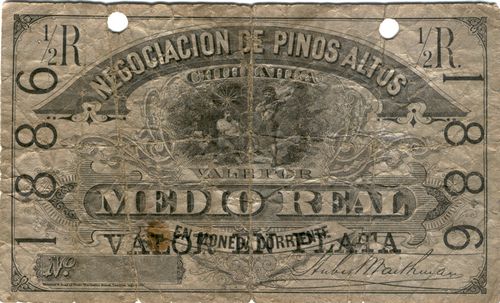 M658b ½r Pinos Altos
M658b ½r Pinos Altos
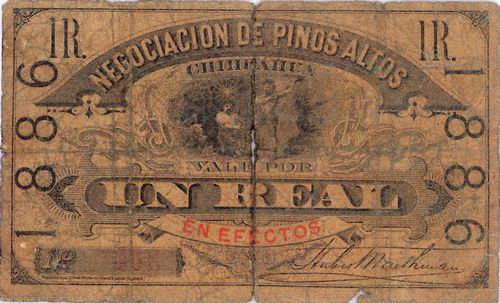
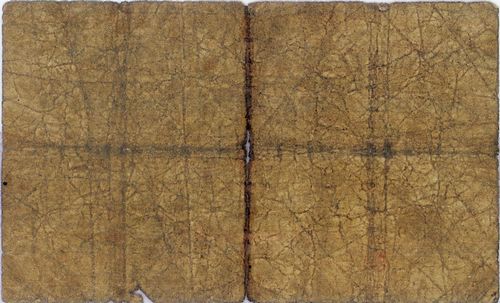 M659 1r Pinos Altos
M659 1r Pinos Altos
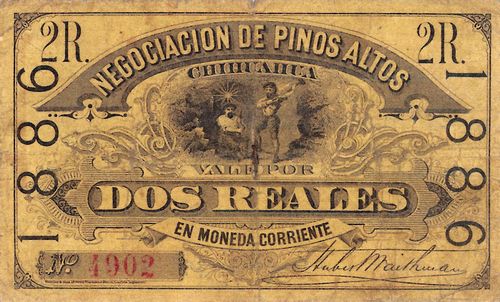
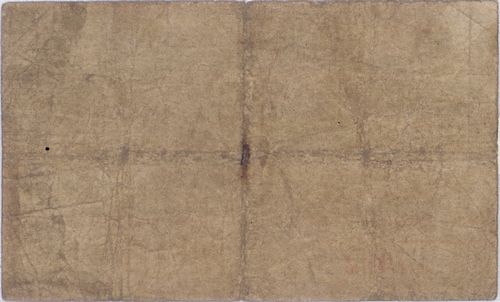 M660 2r Pinos Altos
M660 2r Pinos Altos
Another series had no printer's imprint and was no doubt produced locally.
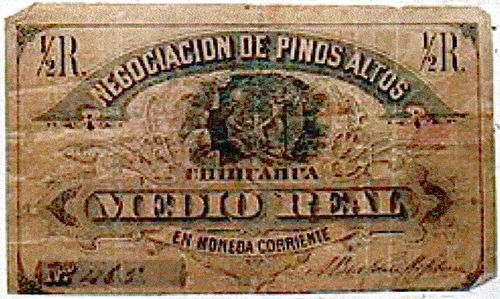 M658a ½r Pinos Altos
M658a ½r Pinos Altos
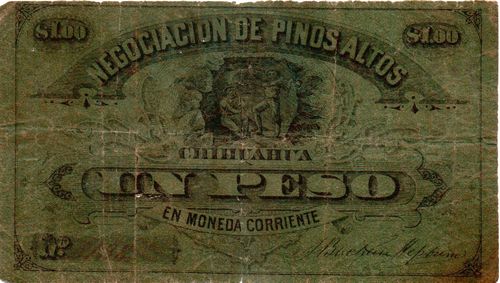
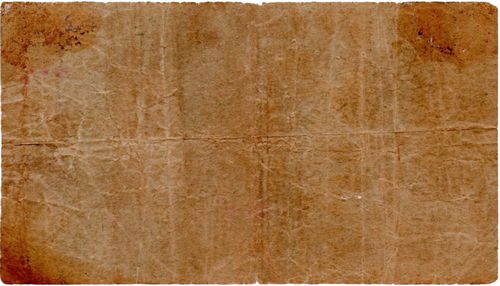 M661 $1 Pinos Altos
M661 $1 Pinos Altos
'CHIHUAHUA' now appears below the vignette, instead of the text 'VALE POR' but, more significantly, the vignette of the two miners is a poor imitation of the original vignette.
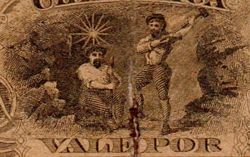
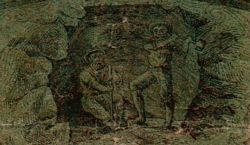
These half real and one peso notes payable in copper coin (en moneda corriente) are signed by Hepburn and so must date to before 1883. On the assumption that the better quality issue would be the earliest, i.e. also before 1883, was this issue a response to a (temporary) shortage of notes?
printed by Waterlow and Sons
| date on note | from | to | total number |
total value |
||
| ½r | EN MONEDA CORRIENTE | |||||
| 1886 | EN MONEDA CORRIENTE o/p VALOR EN PLATA includes numbers 1285 and 4195 |
|||||
| 1r | EN MONEDA CORRIENTE | |||||
| 1886 | EN EFECTOS includes number 366 |
|||||
| 2r | EN MONEDA CORRIENTE | |||||
| 1886 | EN MONEDA CORRIENTE includes number 4902 |
produced locally
| date on note | from | to | total number |
total value |
||
| ½r | EN MONEDA CORRIENTE includes number 465 |
|||||
| $1 | EN MONEDA CORRIENTE includes number 438 |
The signatories are:
|
John George Buchan-Hepburn was born in Smeaton, Scotland on 24 September 1841, the son of Sir Thomas Buchan-Hepburn of Smeaton Hepburn, 3rd Baronet, and Helen Littleinformation courtesy of Michael Snelgrove. He was for several years a subaltern in the 9th Lancers and was quartered with that regiment at Aldershot in 1861, and at Brighton in 1862-1863. He sold out of the 9th Lancers in 1863West Surrey Times, 24 February 1883. As detailed above, he bought the Pinos Altos mine in 1877 and died on 21 January 1883, shot during a protest. |
 |
|
Huberto Waithman: Hubert Waithman was born in England (probably Chorlton, Manchester) on 18 March 1859, to a prominent Quaker family. In 1879 Hubert’s father, Joseph Waithman, John George Buchan-Hepburn, and W. M. Kerr and the Pinos Altos (Mexico) Mining Company Limited made an agreement to acquire the business, mining rights, machinery, etc and “to do all acts necessary for obtaining for the company a legal status in Mexico, or any country in which business may be carried on.” Hubert married Grace Gertrude Winton on 14 December 1887 in Oakland, California and their three children, Joseph deLindeth Waithman, Maude Victoria Waithman and Grace Elizabeth Waithman, were born in Pinos Altos but after Hubert’s death in 1891 their mother took them to live in Hayward, CaliforniaInformation courtesy of Michael Snelgrove. Waithman’s descendants say that he “was shot by bandits near the silver mines", but in a letter, Enrique C. Creel records that he committed suicide at Pinos Altos when his wife discovered that he was having an affair (CEHM, Fondo Creel, [ ], 66088). |
 |
